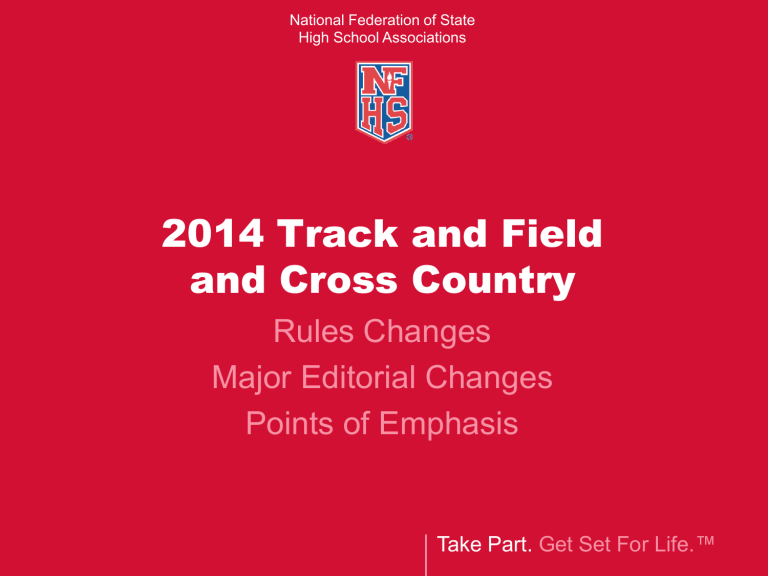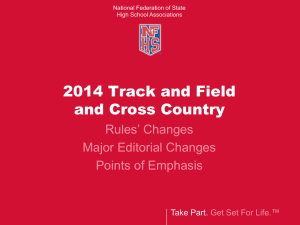2014 Track and Field PowerPoint

National Federation of State
High School Associations
2014 Track and Field and Cross Country
Rules Changes
Major Editorial Changes
Points of Emphasis
Take Part. Get Set For Life.™
2014 Track and Field
Rules Book Corrections
Revised corrections
Page 18, Rule 3-10-1, The field referee or head field judge…weighing and measuring of the implements, including vault poles …
Page 71, 9-6-1 NOTE 2, If more than one visible garment , which extends below the knees, is worn under the uniform top…
Page 80, Item #3, Delete second sentence: The scales typically used are limited to about 40 pounds, therefore, are not usable for this purpose.
Authority of Meet Officials and Games
Committee
Rule 3-1-2
The meet referee, other meet officials or the jury of appeals shall not set aside any rule
Use of Electronic Devices
Rule 3-2-7
Officials may use electronic/wireless communication devices for administrative purposes during the competition only as set forth prior to the start of the meet
Use of Electronic Devices
Rule 3-2-8
Electronic devices may be used in unrestricted areas and coaching boxes, providing the location does not interfere with progress of the meet as determined by the meet referee
• Electronic devices shall not be used to transmit information to the competitor during the race or trial
• Electronic devices shall not be used for any review of an official’s decision
• State associations may also have policies in place to further address the use of electronic devices
Penalties:
• A competitor shall be disqualified from the event
• Team personnel (e.g. coach, manager, etc.) shall be disqualified from further participation in the meet for unsporting conduct
Use of Electronic Devices
Rule 3-2-8
Responsibility to Inspect Poles – Field
Referee, Head Field Judge
Rules 3-10-1, 3-19-3, 7-5-5
Prior to warm-up, the field referee or head field judge shall inspect each pole to be used in competition to verify that the pole is legal equipment
Uniform – Foundation Garment
Rules 4-3-1c(7), 4-3-1c(7) NOTE, 9-6-1c(7)
NOTE 2
Any visible garment(s) worn underneath the uniform bottom and extending below the knees shall be unadorned and of a single, solid color
Any garment worn underneath the uniform bottom and that terminates above the knees is considered a foundation garment and not subject to being a single, solid color
Uniform – Foundation Garment
Rules 4-3-1c(7), 4-3-1c(7) NOTE, 9-6-1c(7)
NOTE 2
Visible undergarment extends below the knees
LEGAL
Visible undergarments extend below knees
Both must be same color
ILLEGAL
Foundation garment ends above knees
LEGAL
Foundation garments end above knees
LEGAL
Uniform – Foundation Garment
Rules 4-3-1c(7), 4-3-1c(7) NOTE, 9-6-1c(7)
NOTE 2
Extends below knees
Visible Undergarment
Garment terminates above knees
Foundation Garment
Garment terminates below knees
Visible Undergarment
A
Uniform – Foundation Garment
Rules 4-3-1c(7), 4-3-1c(7) NOTE, 9-6-1c(7)
NOTE 2
B C
A, B, C
LEGAL
All garments terminate above the knees; thus, all are foundation garments and not subject to single, solid color requirement
Uniform – Foundation Garment
Rules 4-3-1c(7), 4-3-1c(7) NOTE, 9-6-1c(7)
NOTE 2
School mascot
Boxers
Manufacturer’s logo
SITUATION: Following the clerk of the course providing instructions regarding the race to the field of competitors in the 400-meter dash, he/she observes a competitor a) with his boxer shorts exposed under the uniform shorts; b) with a large manufacturer’s logo on a garment under the uniform shorts; and c) with the school mascot on a garment under the uniform shorts. All items terminate above the knees. The clerk has no objections. RULING: Correct procedure. COMMENT:
These items are all considered foundation garments.
Uniform – Foundation Garment
Rules 4-3-1c(7), 4-3-1c(7) NOTE, 9-6-1c(7)
NOTE 2
RELAY UNIFORMS
Relay team members wearing foundation garments are not required to wear the same color foundation garment
The foundation garment does not have to be a single, solid color
This rule also applies to cross country teams
General Rules for Throwing Events
Rule 6-2-9
A pass shall be communicated to the event judge before the start of the trial clock
Javelin Throw
Rule 6-6-1 NOTE
When a rubber tip is used, the metal point shall end in a slightly rounded button shape or other feature onto which the rubber tip shall be attached …
Prescribed Time Limit for Pole Vault
Rule 7-2-11
A competitor shall initiate a trial that is carried to completion within the prescribed time limits, one minute after being called for a trial
• When three or fewer remain in the high jump or pole vault at the beginning of a bar height, the above time shall be increased to three minutes
• When a single competitor, who has won the competition, remains in the high jump or pole vault, the allowed time shall be five minutes
Prescribed Time Limit for Consecutive
Trials in Throwing Events
Rule 6-2-9
By way of the chart, the time limits for consecutive trials in throwing events are now clarified
Pole Vault – Planting Box Padding
Rule 7-5-24
The planting box shall not contain any foreign materials except planting box padding. Such padding, if used, shall meet the applicable ASTM
Specification Standards and can be incorporated into the design of the planting box or can be a padding addition to an existing planting box
• Padding meeting the ASTM Standards may be used immediately, subject to rejection or conditional approval by state association action
• Padding meeting the ASTM Standards will be required for the 2014-15 track season
Pole Vault – Planting Box Padding
Rule 7-5-24
Pole vault planting box padding shall meet ASTM
Specification Standards for the 2014-15 indoor and outdoor seasons
National Federation of State
High School Associations
2014 Track and Field and Cross Country
Major Editorial Changes
Take Part. Get Set For Life.™
Major Editorial Changes
Rules 4-6-3,4 and 5-9
Articles 4-6-3 and 4, addressing how to order reruns after an act of interference, have been moved to Rule 5-9-2 and 3
• ART. 2… If interference occurs in a preliminary heat, the referee may allow the offended competitor or relay team to start in a subsequent heat in the same round of heats if a lane is available, or in the next round of heats, the same as if the offended competitor or relay team had won a place
• ART. 3… If interference occurs in the final heat or section, the referee may order a new race between all those in the finals, or between those who, in the referee’s opinion, are entitled to the privilege
Major Editorial Changes
Rules 5-1-3, 5-2-2
All-weather track surfaces utilizing a painted line to mark the inner edge of the track are now the more commonly-used surface
The order of listing a painted line, followed by a raised curb to designate the inside edge of the track is more appropriate for the construction and design of today’s tracks
• On all-weather tracks, a painted line 2 inches
(5 centimeters) or more in width may be used to mark the inner edge of the track. A solid curb…
Major Editorial Changes
Rules 6-3-1,2 and 7-3-1,2
6-3-1 …with the same best height or distance
6-3-2 When there is a tie at any distance of a throwing event, places and points scored…
7-3-1 …competitors finish with the same best distance or height
7-3-2 When there is a tie at any height or distance of a jumping event, places and points scored…
Other Editorial Changes
3-4-5
3-8-3
4-4 NOTE
When a competitor is disqualified, the referee shall notify, or cause to be notified, the competitor and the competitor’s coach
Deleted this article, as it appears in
3-9-3
…The accommodations should not fundamentally alter the sport, heighten risk…
6-2-10 The time at which the preliminaries in each throwing event must be concluded or completed should be set…
Other Editorial Changes
6-2-12 In two-session meets, it is recommended all competition in throwing…
6-2-14 PEN
6-4-2,
6-5-2,
6-6-2
6-4-3
…coach or event official at the site shall result …disqualification from that event. If the incident…disqualified from further competition in the meet.
Reverses order in which all calibrations are listed – metric, which is the standard for scales and listing of implement weight
The throwing circle shall be level and
8 feet…
Other Editorial Changes
7-1-2
7-2-1
7-2-6 New
7-2-10
…group of competitors in a jumping event .
…To place in a jumping event, a competitor shall have had at least one legal jump.
Contestants shall report promptly to the head event judge at the designated location when the event is announced.
…one minute after being called for a trial, except in the pole vault where the time is 1 ½ minutes. Failure…
Other Editorial Changes
7-4-1,
7-5-1,
7-6-1
7-5-29
The inclination declination in the approach…
8-1-1 NOTE
New
9-6-4 PEN
Appendix A
An unsuccessful trial is charged but not measured
Scoring table for the 1600-meter run is located at www.nfhs.org
, Track and
Field
…disqualification from the meet event …
Adds a statement regarding use of charts and diagrams outside of the body of the rules.
National Federation of State
High School Associations
2014 Track and Field and Cross Country
Points of Emphasis
Take Part. Get Set For Life.™
Throwing implements returned to competitors by officials
Coaches and officials, including all those who may volunteer to assist with administration of the throwing events, must always work together to minimize the risk of injury due to improper return of throwing implements, lack of throwing sectors being cordoned off and/or lack of adequate training for those individuals working the event
A throwing implement should never be thrown or tossed back to the competitor once the trial is completed
There should be a predetermined process and individuals designated to have the responsibility to walk the implements back
Throwing implements returned to competitors by officials
This process should also include the path to follow when walking back to avoid walking through the throwing sector
This process should be carefully reviewed with all those working the event prior to any warm-ups commencing as well as at the coaches meeting and with the athletes as they report to the event for warmups and competition
Everyone involved should always be alert, as the unexpected can always happen
Equally important is the coach following similar procedures with his/her athletes during practice
Proper coaching requires staying up-to-date on rules and techniques
The sport of track and field, like other sports, continues to have advancements made in equipment, uniforms, techniques and training
Such advancements may be related to improved performance, better and more efficient training and many times, changes which reduce the risk of injury
As an example, the new standard for the pole vault plant box padding has the potential to minimize the risk of injury to a vaulter which 1) makes the event safer and 2) allows the vaulter to minimize the effects of potential injuries and enjoy greater amounts of participation
Proper coaching requires staying up-to-date on rules and techniques
Coaches have the responsibility to study the rules, attend in-person and online clinics, read current sport literature on training and new equipment and learn from others to stay current with the advancement and opportunities in the sport
Just as it is a goal for our athletes to continue to get better, much of that advancement is contingent upon the coach staying up-to-date on rules, techniques and risk minimization in the sport
Coaches “getting it right” with uniforms
Track and field is a sport which traditionally has colorful uniforms and styles that serve different purposes for performance
Having the athletes show up for competition in a legal uniform starts with the coach
Any time there is a violation due to uniforms, it is a violation that could have been avoided
The officials do not have the responsibility for putting athletes in legal uniforms, but do have the responsibility to enforce the rules
Coaches “getting it right” with uniforms
It is the coach who must know the rules and then take the time each season to educate his/her athletes on the rules and to come ask questions of the referee if the athlete wants to wear a different garment due to weather or an injury
This season, there are changes in the uniform rule that coaches must educate their athletes to these rule changes and emphasize the importance and responsibility of each athlete to be accountable for his/her actions to come ready to participate in a legal uniform
Importance of proper training of volunteers to work the meet
It takes a number of volunteers to work a track and field meet
Unlike sports such as soccer, volleyball or basketball, where there is a defined number of officials who are trained and generally certified as an official to work the contest, track and field meets may only have a few certified officials and the rest are volunteers to work the meet
During the regular season, these volunteers may or may not know a significant amount about the details of officiating the events they are working
They are versed in the basics and then expected to run off a good event
In order to run a fair, safe and well-administered meet, the schools must take time to adequately train the individuals with the knowledge and skills necessary to work the event
Importance of proper training of volunteers to work the meet
Athletic directors and coaches should work together to develop a training system and materials to educate these individuals who are going to work their meets
Local officials will also be of assistance, as they may be able to provide training materials or have training materials on a Web site
Many state associations have material on their Web sites that are useful
The NFHS provides an Officials’ Manual and the online Pre-
Meet Notes, which are suitable for use with volunteers
To avoid problems and run an efficient and enjoyable meet, take time to properly train the many volunteers who will work your track and field meets
NFHS Track and Field
Pre-Meet Notes
NFHS Track and Field
Pre-Meet Notes will be available online at http://www.nfhs.org/track.aspx
and https://www.usatf.org/groups/o fficials/newsletters/
NFHS Track and Field Pre-Meet
Notes are made possible through the cooperative efforts of the NFHS Track and Field
Rules Committee and USA
Track and Field Officials
Training Subcommittee
National Federation of State
High School Associations
Thank You for your support of
High School Athletics!
www.nfhs.org
Take Part. Get Set For Life.™





